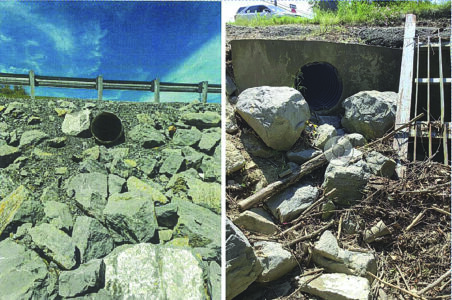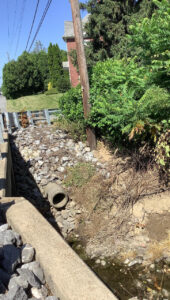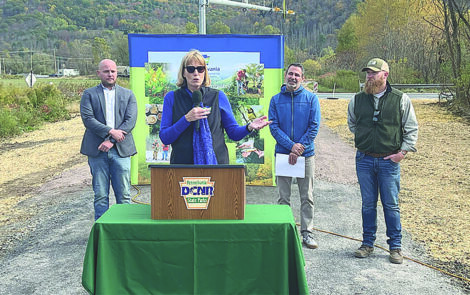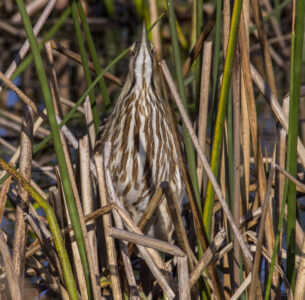Extensive network of outfalls studied, mapped via collaborative, proactive Williamsport stormwater project
- PHOTO PROVIDED Shown are two stormwater outfall in this photo by the Middle Susquehanna Riverkeeper Association. More than 360 outfalls were recently studied and mapped out as part of the Greater Williamsport stormwater system project.
- PHOTO PROVIDED Shown is a stormwater outfall in this photo by the Middle Susquehanna Riverkeeper Association. More than 360 outfalls were recently studied and mapped out as part of the Greater Williamsport stormwater system project.
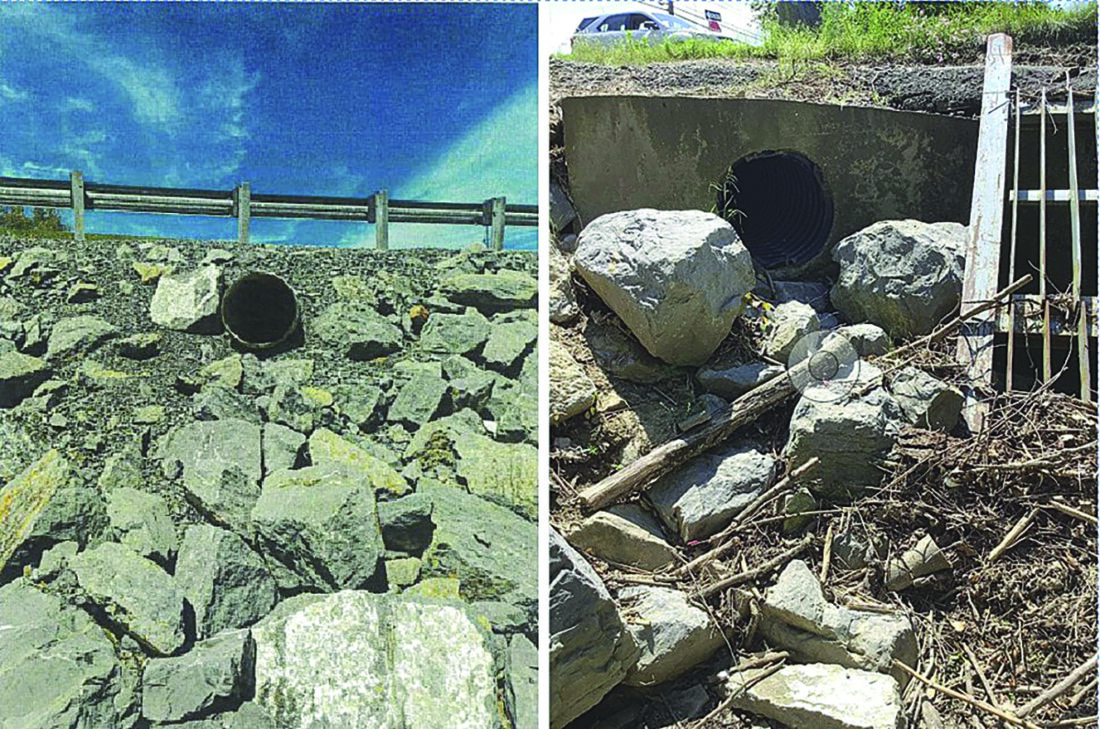
PHOTO PROVIDED Shown are two stormwater outfall in this photo by the Middle Susquehanna Riverkeeper Association. More than 360 outfalls were recently studied and mapped out as part of the Greater Williamsport stormwater system project.
An aquatic ecologist with ample experience in studying urban streams and stormwater issues, Dr. Leslie Rieck has developed an appreciation for the city of Williamsport’s place within the flow of the greater Susquehanna watershed.
“It is such a unique river town. You have these mountains and hills and intact forest and trout streams coming down and hitting an urbanized area with an MS4 (Municipal Separate Storm Sewer System),” she said. “From a scientific standpoint, this area is a really great spot to look at how quickly – or not – different types of layouts can impact waterways with such an abrupt transition. We have such clean water coming into the city, and it really isn’t that far to get it to the river and keep it clean.”
Rieck was hired by Lycoming College’s Clean Water Institute to help cultivate local partnerships for the MS4 program, an effort that has since been hampered by COVID and a lack of suitable stormwater system maps.
“It is an older city, and the infrastructure isn’t mapped out the way we would do it if we were building it today,” she said. “So that is where we developed this creative way to partner and do something very productive for the city and for scientific research – so we could figure out where water was flowing and make sure the city was satisfying its environmental and regulatory goals.”
Creative

PHOTO PROVIDED Shown is a stormwater outfall in this photo by the Middle Susquehanna Riverkeeper Association. More than 360 outfalls were recently studied and mapped out as part of the Greater Williamsport stormwater system project.
collaboration
Nationally, the Environmental Protection Agency, with an assist from the state’s Department of Environmental Protection, defines which municipalities qualify for MS4 status.
Williamsport is unique, according to the city’s Water and Sanitary Authority’s Environmental Manager Cheryl Terpak, because the authority helps the city manage the MS4 permit requirements and inspections.
“Falling under the MS4 means that we are required to monitor what goes into the stormwater system through various means and what comes out of it. Part of that permit requires that we do periodic inspections of what are called outfalls,” she said. “An outfall is an area where stormwater exits into a waterway.”
This opened the door for collaboration between Williamsport’s Water and Sanitary Authority and Lycoming College.
“We thought it would be a great opportunity to bring on an intern to help us do those stormwater inspections and also give that individual an opportunity to learn something about how the sanitary authority works and how we deal with regulatory bodies,” said Terpak. “Dr. Rieck connected us with Ben (Fry) and we worked with him throughout the summer of 2024 to do a lot of the inspections and mapping of Williamsport’s outfalls.”
It was a process the recent Lycoming College graduate assumed at first wouldn’t be too difficult to tackle.
“Williamsport’s not a really large city when you look at population, so I initially figured there’d be like 100 outfalls. The city itself thought there were less than 100 outfalls,” said Fry. “When I got on the project, they were like, ‘No, there’s like 364 of them!'”
The discrepancy, according to Terpak, has a lot to do with the history of Williamsport and the waterways that intersect it.
“Many of them go underground for a while and then resurface, and the original assessment really didn’t account for all the stormwater inlets you see on the streets that normally would go to a catch basin, but really are dumping water directly into a waterway,” she said. “When the Williamsport Sanitary Authority took over most of the responsibilities of the stormwater program, one of the first things we started but then Ben helped with was to identify all those additional outfalls and put them on the inspection schedule.”
It made for a busy summer.
“It was definitely a big undertaking,” said Fry, who this summer has been hired full-time by the Williamsport Water and Sanitation Authority. “I think our record was to get like 40 done in a day.”
He used an iPad with a tracking system on it. At each outfall, he would take a picture, then physically look over each, seeing if there was a flow, if there should be a flow and what direction it should be going.
“We’d look at size of the outfall, material used and the structure of it, what it was connected to, rate of flow, if there was an odor, odd color or other notable trait in the flow, and connectedness,” he said. “There was really only one spot throughout the summer when we were surprised with what we saw. It was an industrial area and we saw a flow we thought we shouldn’t see. We traced it back. Ultimately, we figured it out as coming from a permitted source.”
Monitoring and
mapping
Monitoring these outfalls on a regular basis allows the authority to then catch potential pollution cases more proactively, an experience they witnessed first-hand early in the process.
“At one site, we inspected an outfall during a dry period, which is at least 48 hours without precipitation, and didn’t see a flow. Six months later, we went back to that outfall under dry conditions and we saw pretty significant flow,” said Terpak. “The water didn’t have any noticeable odor, color or sheen, but one test showed higher chlorine and that can be a parameter to indicate drinking water. We had our water authority outside crew trace it back at least a half-mile away to a leaky valve in the water system. Once that was fixed, the flow at the outfall stopped, so certainly doing these inspections is important.”
Fry is taking all the data from each outfall he has studied and mapped it out using GIS software to help improve the overall grid of information not only for access to each outfall, but to show the potential flow of stormwater across the city.
“The map makes it much easier to potentially track pollution and deal with repairs and maintenance,” he said. “As Arc GIS advances, you can add more detail into each map, characteristics onto each point and expand the base of knowledge of each outfall.”
That information can be especially vital when used in conjunction with reports from the general public.
“In the last year or so, we had a report come in to the sanitary authority that someone saw discoloration coming out of a pipe into the West Branch of the Susquehanna River,” said Terpak. “We were able to trace that back upstream to the industry that had an unintentional discharge, I would say – a connection they thought went to sanitary that instead went to stormwater. We were able to work with that industry to determine what the pollutant was and correct the issue.”
Next steps
The interactive map of outfalls and stormwater flow across Williamsport has the potential to evolve into something really unique, according to Rieck.
“I think one of the neat things we could do is develop a map where the outfalls are to develop an idea where the storm sheds are within the city,” she said. “If you map these watersheds, using a traditional method with a topographic map or a digital elevation model, you end up with something that looks like a standard watershed – a dendritic pattern – and factually we know that’s not what’s happening because cities aren’t shaped like that, neither are the pipes nor the sewers.”
Eventually, that could mean a map that shows where drops of water placed at a specific site in the city will eventually wind up.
“So we have a map, and we say you are on corner of Fourth and Market, this is where that water is going,” said Rieck. “So, if we put something in like the rain garden at The Potting Bench, since that is a fairly new project, what water is that taking out (of the city’s stormwater flow) and what water is that impacting so when we find something that works, we know what is being addressed and what impervious surfaces are being mitigated.”
In the meantime, there is plenty people can do to mindfully make a difference by remembering that so much of what we do winds up directly into stormwater, local streams and the river – and some are things that people don’t really think about, according to Terpak.
“For example, when you mow your lawn and your grass clippings wind up in the street and it rains, they likely will wind up washing into a waterway and those clippings can release a lot of nutrients into that waterway,” she said. “Some nutrients are OK, but too many nutrients can feed algae and cause algae blooms which can cause plants to die because not enough sunlight is getting down into the water, and when plants die, there is less oxygen available for fish.”
Another recommendation involves where you wash your car.
“The state’s Department of Environmental Protection suggests that if you are using soap to wash you car, that you do so in a grassy area. That way, the soil can help soak up the extra water and soap, which helps filter things out instead of it running directly into a storm drain and into a waterway,” Terpak said. “Each of these things may seem little, but help reduce potential pollutants from going directly into our streams and river where they can build up and cause issues.”
Ultimately, it is a reminder that many different groups are working regularly to be proactive, Terpak added.
“Municipalities and others are required to provide all their employees annual training on good housekeeping on things like using certain chemicals and other things so they don’t go down into the stormwater system and that those things are disposed of properly,” she said. “There are many things going on behind the scenes to ensure that our stormwater systems stay as clean as possible, and those efforts all trickle down to our waterways.”
The Middle Susquehanna Riverkeeper Association serves an 11,000-square-mile watershed of the Susquehanna River, including Sullivan, Lycoming, Clinton, Union and Northumberland counties. Read more at www.middlesusquehannariverkeeper.org.

